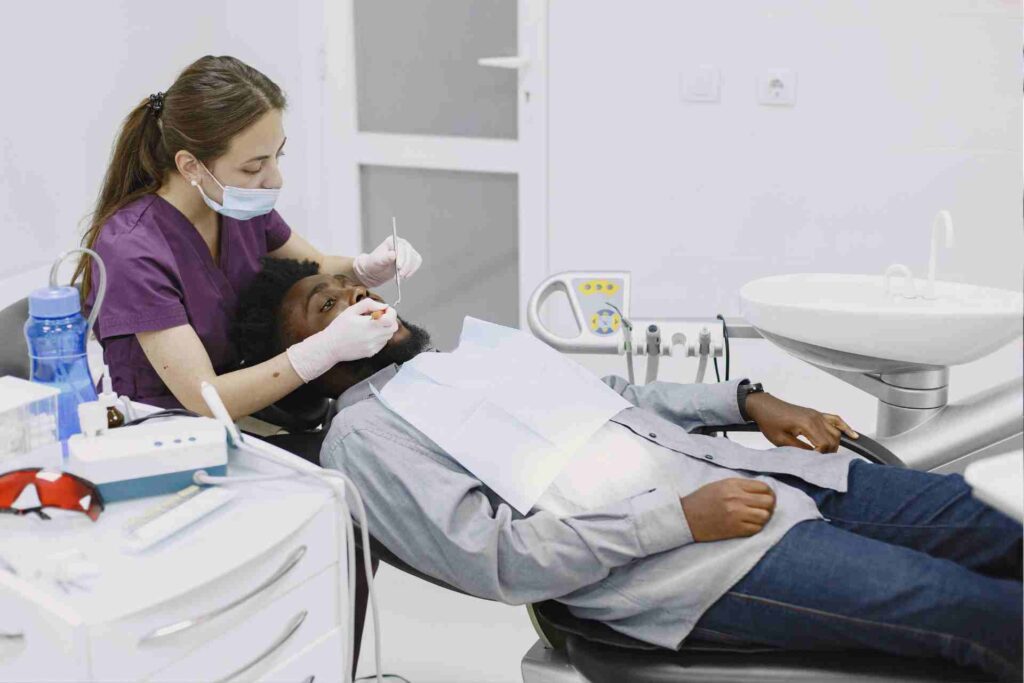What’s the difference between a dentist and an orthodontist? This is one of the most common questions I get.
A dentist focuses on your overall oral health with things like cleanings, fillings, and gum care. An orthodontist is a specialist who corrects the position of your teeth and jaw using braces or aligners.
Every orthodontist is a dentist first, but not every dentist is trained in orthodontics.
Is My Dentist Also an Orthodontist?
It’s easy to assume your dentist can handle everything related to your smile, and for most day-to-day care, that’s true.

General dentists, like me, take care of everything from cleanings to fillings and even cosmetic treatments like whitening or veneers. Some of us are also trained to offer clear aligners like Invisalign, which can work well for simple alignment cases.
But here’s the key difference: when teeth need to be moved in a more complex way or your bite needs correcting, that’s when an orthodontist steps in. They’ve completed extra years of specialized training focused entirely on how teeth and jaws develop and move.
The American Association of Orthodontists breaks it down well: all orthodontists start as dentists, but their added expertise means they’re the go-to for more advanced alignment care.
What Does a Dentist Do?
Daily Oral Care and Disease Prevention
Let’s start with the basics. Dentists are your first line of defense when it comes to keeping your mouth healthy. We handle your routine checkups, cleanings, and early detection of problems you might not even know are brewing (think tiny cavities or the first signs of gum disease).
We’re also big on prevention. Things like fluoride treatments, sealants, and cleanings help protect your enamel, stop decay in its tracks, and set you up for fewer dental issues down the road.
Behind the scenes, most of us are constantly learning, too. I personally take advanced dental courses to stay current on the latest techniques, tools, and materials. Dentistry is always evolving, and we evolve with it to give you the best care possible.
Restorative and Cosmetic Treatments
When something is not quite right, maybe a tooth is chipped, aching, or missing altogether, that is where restorative care comes in.
Dentists handle everything from fillings and crowns to root canals and bridges. The goal is to bring your teeth back to full function and comfort so you can eat, speak, and smile with ease.

Many of us also help patients feel more confident in their smiles through cosmetic dentistry. Veneers, professional whitening, and full smile makeovers are all part of what we do. Many general dentists earn specialized certifications and training in aesthetic techniques because helping someone love their smile is one of the most rewarding parts of this job.
Curious what our day-to-day looks like? Here is a peek into my daily routine that might surprise you with how much variety there is.
Dentist vs Orthodontist: Education and Training Differences
How Long Does It Take to Become Each?
Becoming a dentist usually involves about eight years of education, starting with undergraduate studies and continuing through dental school. This is where future dentists develop both clinical skills and strong foundation in oral health science.
Orthodontists complete the same dental training but also spend an additional two to three years in a residency program that focuses entirely on facial development, bite alignment, and tooth movement.
The path from student to specialist is longer, and the orthodontist training timeline reflects the complexity of their work.
Different Areas of Expertise
Dentists are trained to care for the whole mouth. We handle everything from cavities and gum disease to crowns, root canals, and even cosmetic improvements. Think of us as your go-to for anything related to everyday oral health and function.
Orthodontists, on the other hand, focus on one very specific part of dentistry: alignment. Their entire specialty revolves around how your teeth and jaws fit together.
It is why that extra training matters. Orthodontists study facial growth, bone movement, and jaw relationships in depth. Many go through highly competitive programs, and some even train at top-ranked dental schools with advanced orthodontic residencies.
Both roles are important. But when your goal is alignment, your orthodontist has the tools and training to take it all the way.
What Does an Orthodontist Do?
As mentioned above, orthodontists specialize in movement, specifically how your teeth and jaw align and function together. Their job is to diagnose and correct misalignment using treatments like:
- braces
- clear aligners
- retainers
- expanders

Orthodontists focus on improving how your bite works and how your jaws develop. That means they are thinking long term, looking at how early signs of crowding or misalignment could affect your smile years down the road.
They often treat:
- crooked or crowded teeth
- bite issues like overbites and underbites
- gaps between teeth
- jaw misalignment
- facial growth patterns in younger patients
And yes, a lot of people wonder why orthodontists do not pull teeth as often anymore. Thanks to early intervention and techniques like jaw expansion, they often create space without extractions.
Their work blends aesthetics and function. The result is a smile that looks great but feels even better and works the way it should.
FAQs About Dentists and Orthodontists
Is it better to see a dentist or orthodontist?
It depends on what you need. For cleanings, cavities, or gum care, start with your dentist. If your concern is crooked teeth or bite issues, your dentist may refer you to an orthodontist for specialized care.
Who is more qualified, a dentist or orthodontist?
Both are highly trained professionals. Orthodontists begin as dentists, then complete several more years of focused education in alignment and bite correction. That extra training makes them the go-to for moving teeth safely and effectively.
What can an orthodontist do that a dentist cannot?
Orthodontists are trained to handle complex cases involving jaw development, bite correction, and major alignment shifts. They use specialized tools like expanders, elastics, and anchorage systems that general dentists typically do not use.
Do orthodontists only do braces?
Braces are a big part of their work, but not the only part. Orthodontists also offer clear aligners, retainers, early treatment for kids, and strategies to guide jaw growth. Their role extends beyond aesthetics to how the mouth functions as a whole.
Is a dentist better than an orthodontist for Invisalign?
Dentists can offer Invisalign, especially for simpler alignment needs. But orthodontists have deeper training in tooth movement, which often makes them a better fit for more advanced or complex Invisalign cases.
Can an orthodontist do fillings?
No. While orthodontists are licensed dentists, they do not perform general dental treatments like fillings or cleanings. You would still visit your general dentist for those types of care.
Why do orthodontists not pull teeth anymore?
Tooth extractions were more common in the past. Today, orthodontists often use expansion techniques or early intervention to create space naturally. The goal is to preserve as many natural teeth as possible while achieving the best result.
Key Takeaways
- Dentists focus on your oral health including cleanings, fillings, and gum care
- Orthodontists specialize in aligning teeth and correcting bite issues
- All orthodontists are dentists, but not all dentists are orthodontists
- Dentists handle most routine care and cosmetic treatments
- Orthodontists undergo additional training for complex alignment and jaw concerns
- For general care, see your dentist first
- For straightening teeth or fixing your bite, an orthodontist may be the next step
Stay empowered and proactive. Follow @joycethedentist for smile care tips, dental inspo, and behind-the-scenes of real-life dentistry!





















